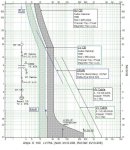This is a great discussion as I have never been able to identify the correct application of the 250% rule for the pri. OCPD but still protect the primary cable.
One thing that would be very helpful would be if someone were to post a diagram showing a 75kva 480-208Y/120 transformer which included where the primary tap originates, the location of a 250% OCPD and the loacation of the 125% sec OCPD as well as the maximum allowable distance for the tpas that would be much appreciated.
I don't think I have a diagram showing this, but let me see if I can explain it...
Let's assume that your 75kVA transformer is being tapped from a 225A feeder (#4/0 AWG Cu).
The location of the tap is irrelevant to the Tap to a Transformer rule in 240.21(B)(3). The tap can be anywhere on the 225A feeder, eg, 50' from the c/b, 125' from the c/b, 247' from the c/b, etc. It doesn't matter.
The 25' refers to the distance of
both the primary and secondary conductors together. See 240.21(B)(3)(3). So on the primary, you could run the tap conductors 10' from the tap location to the xfmr, this would allow you 15' to run the secondary conductors to the secondary OCPD. Or you could run the primary (tap) conductors 19' to the xfmr, and this would leave 6' for the secondary conductors. Under 240.21(B)(3), the total length of the primary plus secondary conductor cannot exceed 25'.
Per 240.21(B)(3)(1), the primary (tap) conductors must have a minimum ampacity of at least 1/3 the rating of the primary OCPD. This would mean you would need tap conductors of at least 75A because of the feeders 225A c/b. However, the conductors must also be sized to carry the load per 215.2. If the load on the transformer was 72kVA non-continuous, then the primary load current is 86.6A, and the primary conductors would need an ampacity of at least 86.6A. #3 Awg Cu has an ampacity of 100, which is sufficient for the load served and complies with 240.21(B)(3)(1), so that would be the minimum primary (tap) conductor size.
Looking at the secondary conductor size, 240.21(B)(3)(2) requires the secondary conductor to have an ampacity of at least (480/208)*(225/73)= 173 Amps. But again, the feeder must be capable of carrying the load which is 199.9Amps at 208V. So the minimum size for the secondary conductors and c/b would be 200A in this example. #3/0 Awg Cu conductors would meet the requirements in 240.21(B)(3)(2) and (B)(3)(5).


